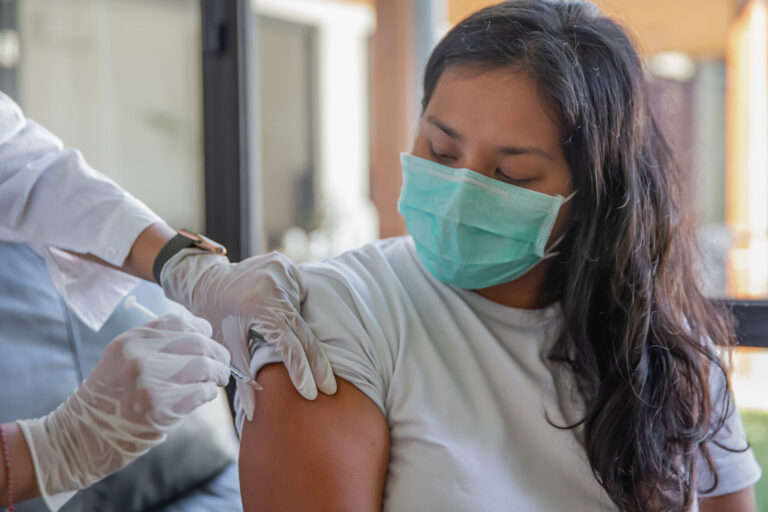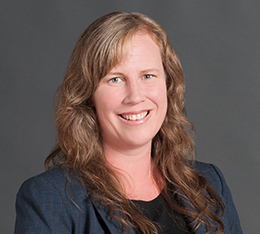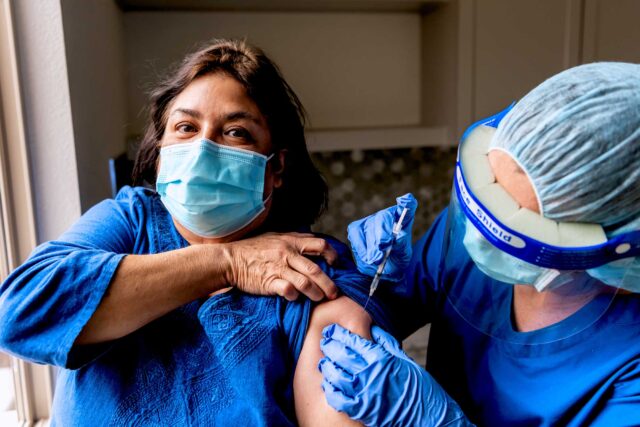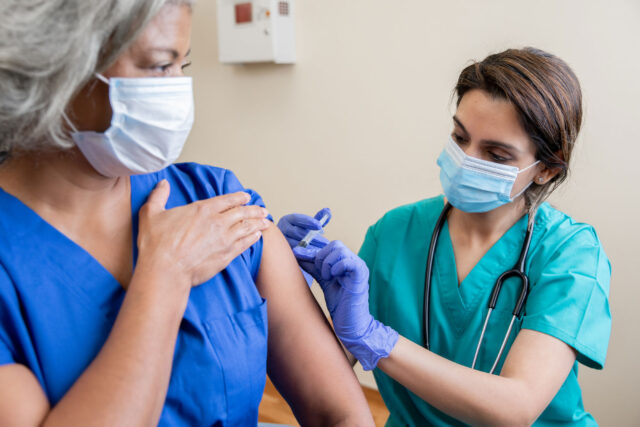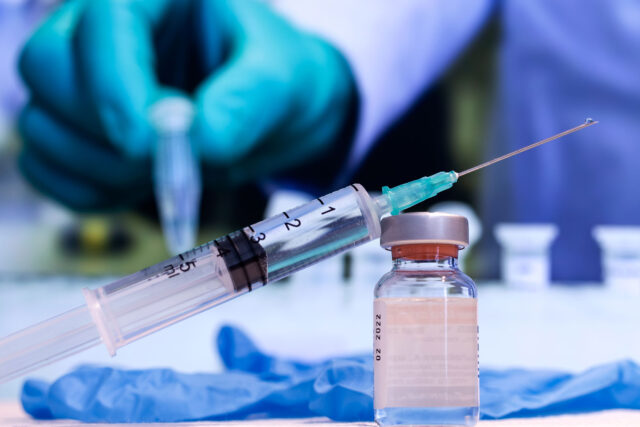Health equity has been a major concern for California throughout the COVID-19 pandemic. While the state has made good progress on overall vaccination rates, recent data released by the California Department of Health Care Services (DHCS) raise questions about equitable access. The statewide vaccination rate for the eligible population (ages 12 and older) is about 80% for those with at least one dose and about 71% for those who are fully vaccinated. But there are large differences across communities, with lower vaccination rates among Medi-Cal enrollees, residents in predominantly Latino neighborhoods, and residents in high-poverty neighborhoods.
In general, counties with relatively high overall vaccination rates have higher vaccination rates among those who enroll in Medi-Cal, the state’s public insurance program for low-income Californians. Bay Area counties boast the highest vaccination rates, with upwards of 90% of the eligible population with at least one dose of the vaccine, compared to nearly 80% in larger Southern California counties like Los Angeles and Orange, and considerably lower rates in the Inland Empire, Central Valley, and Far North regions of the state.
Statewide, vaccination rates among those covered by Medi-Cal lag behind vaccination rates for the total population by about 25 percentage points, though again there are differences across counties. For example, San Diego County has a relatively high overall vaccination rate (86%), but among those covered by Medi-Cal, only 56% are vaccinated. Smaller counties in the northern region of the state have some of the lowest overall vaccination rates but smaller gaps between all residents and those with Medi-Cal coverage.
Undoubtedly, the factors that affect whether and when people get vaccinated are varied and complex, including how easy the vaccine is to get, people’s prior experiences with the health care system, and religious or political views, among others. Examining zip code data allows us to drill down further to assess what may be driving differences in vaccination rates at a local level.
Given the state’s focus on health equity, we explore differences across zip codes based on the share of people living in poverty and the share who are Latino. For the first several months of 2021, vaccination rates in zip codes with high poverty rates and large shares of Latino residents were considerably lower than those with low poverty rates and fewer Latino residents. The good news is that, since mid-April, when more Californians (all residents ages 16+) became eligible to be vaccinated, differences in vaccination rates between zip codes with high and low shares of Latino residents have narrowed considerably. Unfortunately, there seems to have been little progress based on poverty: vaccination rates in zip codes with high poverty still lag behind low-poverty zip codes by about 17 percentage points.
California policymakers have made concerted efforts to provide equitable access to vaccines by targeting lower-income communities and those hard hit by the pandemic with dedicated supplies of vaccine doses. When we examine how vaccine supply distributions relate to zip code vaccination rates, we see that targeted supplies are correlated with higher vaccination rates. However, we still see that people living in zip codes with higher poverty rates and more Latino residents have lower vaccination rates. These relationships were reduced after accounting for the median age of residents, suggesting that some of the relationship between lower vaccination rates in these zip codes is related to having fewer older residents.
Clearly more needs to be done to boost vaccination rates among low-income Californians. Recognizing the important role of Medi-Cal managed care plans in distributing vaccines to low-income residents, DHCS has allocated up to $350 million for a vaccine incentive program—of which $100 million can be used to provide things like grocery gift cards directly to Medi-Cal beneficiaries—to help close the vaccination gap. Another promising strategy involves using school sites to increase vaccination among young people and their families. As younger children may become eligible to receive the vaccine in the coming weeks, expanding resources and outreach to parents—especially those in lower-income neighborhoods—will be critical.
